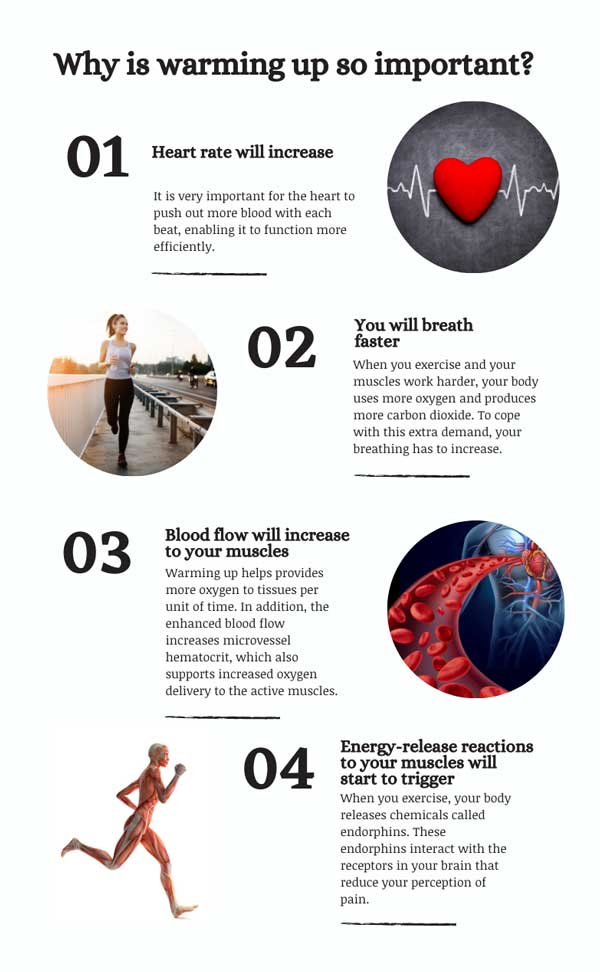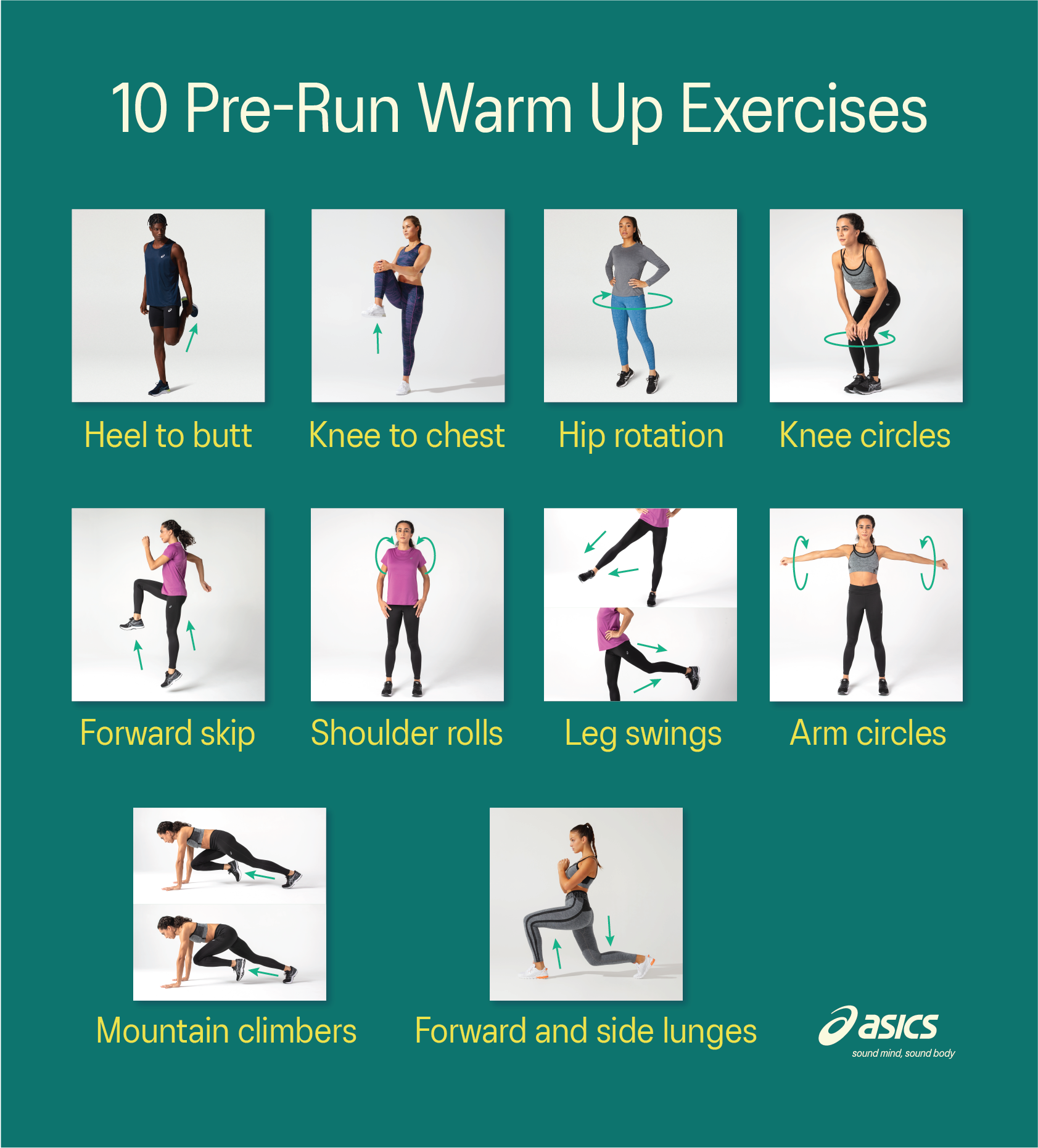Imagine you’re about to embark on a journey of physical activity, whether that be a challenging workout or a refreshing run. Before you jump right into the action, it’s crucial to take a moment to warm up your body properly. This article highlights the significance of warming up before exercise and provides helpful tips on how to do it right. By taking just a few minutes to prepare your muscles and joints, you’ll not only enhance your performance but also reduce the risk of injuries. So, let’s dive into the importance of warming up and discover the best ways to ensure your body is primed and ready for the adventure ahead.

The Importance of Warming Up
Before diving into your exercise routine, it is crucial to warm up your body and prepare it for the physical demands ahead. Warming up offers a multitude of benefits that not only enhance your performance but also help prevent injuries. With just a few minutes dedicated to a proper warm-up, you can improve flexibility, increase blood flow, prepare your mind, and activate your nervous system.
Enhances Performance
Warming up effectively enhances your overall performance during exercise. By increasing your muscle temperature, your body becomes more efficient at producing and utilizing energy. As a result, you will experience improved muscle elasticity, enhancing the contraction of your muscles. Additionally, warming up enhances oxygen delivery to the muscles, allowing them to work optimally and improving your overall performance.
Prevents Injury
One of the key reasons to warm up before exercise is to prevent injuries. A proper warm-up prepares your muscles and tendons for physical activity. By gradually increasing your range of motion through warm-up exercises, you reduce the risk of strains, sprains, and other common exercise-related injuries. Moreover, warming up activates your stabilizer muscles, which support major muscle groups and provide stability during movement, further lowering the risk of injury.
Improves Flexibility
Regularly incorporating a warm-up routine into your exercise regimen can significantly improve your flexibility. As you warm up, your muscle extensibility increases, allowing for a greater range of motion in your joints. This enhanced joint range of motion not only helps improve your exercise technique but also plays a vital role in preventing injuries caused by limited motion or sudden movements. Additionally, warming up reduces muscle stiffness, improving your overall flexibility and making exercise more comfortable and enjoyable.
Increases Blood Flow
Warming up prior to exercise leads to an increase in blood flow throughout your body. As your heart rate and blood pressure rise during warm-up exercises, the blood supply to your muscles also increases. This heightened blood flow ensures better nutrient and oxygen delivery to the muscles, enabling them to work efficiently. Moreover, the increased blood flow aids in removing waste products from your muscles, helping to reduce muscle soreness and fatigue.
Prepares the Mind
A warm-up not only prepares your body but also plays a crucial role in preparing your mind for exercise. By engaging in a warm-up routine, you establish mental focus and concentration. This mental clarity helps you stay in the present moment and be more mindful of your movements, greatly improving your overall exercise performance. Additionally, a proper warm-up reduces stress and anxiety, allowing you to approach your workout with a clear mind and a positive attitude.
Activates the Nervous System
Warming up actively engages your nervous system, which controls the coordination and movement of your muscles. By firing neural pathways, a warm-up improves your reaction time, enhances coordination, and optimizes motor control. This activation of the nervous system facilitates efficient muscle recruitment during exercise, leading to better overall performance and reduced risk of injury.
How to Warm Up
Now that we understand the importance of warming up, let’s delve into how to perform an effective warm-up routine. By following these guidelines, you can maximize the benefits of your warm-up and further enhance your exercise experience.
Duration and Timing
A warm-up typically lasts between five to ten minutes, depending on the intensity of your workout. Allocating this brief period before each exercise session is essential for priming your body for physical activity. Furthermore, it is particularly important to perform a more extensive warm-up prior to engaging in intense workouts to adequately prepare your body for the demands it will face. Remember, skipping warm-up exercises can lead to decreased performance and an increased risk of injury.
General Warm-Up
Start your warm-up with low-intensity exercises that engage your major muscle groups. This general warm-up gets your blood flowing and gradually increases your heart rate. Examples of exercises to include in your general warm-up routine are light jogging, cycling, or jumping jacks. These activities should be performed at a comfortable pace, aiming to gradually increase your body temperature and prepare your muscles for more specific movements.
Specific Warm-Up
Following your general warm-up, transition into specific warm-up exercises that mimic the movements you will be performing during your main workout. For instance, if you plan on participating in a weightlifting session, warm up with lighter weights or resistance bands. If your workout involves running, incorporate exercises like high knees or butt kicks. These specific warm-up exercises further prepare your body for the specific movements and help activate the muscles you will be utilizing.
Dynamic Stretching
Instead of relying solely on static stretching, which is better suited for cool-down exercises, incorporate dynamic stretching into your warm-up routine. Dynamic stretching involves controlled, repetitive movements that gently take your joints and muscles through an extended range of motion. Examples of dynamic stretches include leg swings, arm circles, or walking lunges. By incorporating dynamic stretching, you can enhance muscle activation, increase muscle temperature, and improve joint mobility.
Cardiovascular Exercise
Including cardiovascular exercises, such as brisk walking or light jogging, in your warm-up routine has numerous benefits. Cardiovascular warm-up activities raise your heart rate and blood pressure, facilitating increased blood flow to your muscles. This increased blood flow ensures that essential nutrients and oxygen are efficiently delivered to your working muscles. By engaging in cardiovascular warm-up exercises, you are not only preparing your body for the upcoming physical activity but also promoting cardiovascular health.
Joint Mobility Exercises
To further enhance your warm-up routine, incorporate joint mobility exercises. These exercises focus on improving the range of motion of your joints, making them more supple and resilient. Joint mobility exercises can include wrist circles, ankle rolls, or shoulder rotations. By performing these exercises, you increase the lubrication in your joints, improve their flexibility, and reduce the risk of joint-related injuries during exercise.
Sport-Specific Movements
Tailoring your warm-up routine to the specific activity or sport you will be engaging in allows for a more targeted and effective warm-up. If you are preparing for a soccer match, for example, practice dribbling, passing, and shooting drills during your warm-up. By rehearsing sport-specific movements, you activate the muscles involved in those movements, fine-tune your motor skills, and mentally prepare for the upcoming activity.
Mental Preparation
An often overlooked aspect of a warm-up routine is mental preparation. Taking a few minutes to focus on your mindset can significantly impact your exercise performance. Prior to starting your physical warm-up, engage in relaxation techniques such as deep breathing or visualization exercises. These techniques help reduce stress and anxiety while promoting a calm and focused mental state. By cultivating a positive mindset during your warm-up, you set the stage for an enjoyable and successful workout.
Cool Down
Just as warming up is crucial, so is properly cooling down after exercise. The cool-down phase allows your body to gradually transition from a state of high activity to a state of rest. This gradual decrease in intensity is essential for preventing post-exercise dizziness and promoting muscle recovery. Engage in activities such as slow walking or light stretching to bring your heart rate and breathing back to a resting state. Cooling down assists your body in removing waste products, such as lactic acid, from your muscles, minimizing post-workout soreness.
Gradually Decrease Intensity
During your cool-down, it is essential to gradually decrease the intensity of your exercise. Abruptly stopping intense physical activity can lead to blood pooling in your extremities, potentially causing dizziness or fainting. By gradually reducing the intensity of your exercise, your heart rate and blood pressure have enough time to normalize.
Slow Walking or Light Stretching
Choose activities that allow your body to slowly return to a resting state during the cool-down phase. Slowing down your pace and engaging in gentle movements, such as slow walking or light stretching, can help ease your body out of the intense workout and promote relaxation.
Promotes Muscle Recovery
The cool-down phase plays a vital role in promoting muscle recovery. By facilitating blood circulation and gently stretching your muscles, a proper cool-down reduces muscle soreness and stiffness. The enhanced blood flow during cool-down aids in the removal of waste products accumulated during exercise, promoting faster muscle recovery and minimizing post-workout discomfort.
Prevents Post-Exercise Dizziness
Intense physical activity causes blood to be directed towards your working muscles. By suddenly stopping without a proper cool-down, blood can pool in your extremities, leading to post-exercise dizziness. Cooling down allows a gradual redistribution of blood flow, ensuring that an adequate supply reaches your brain, reducing the likelihood of feeling lightheaded or dizzy after your workout.
In conclusion, warming up before exercise is of utmost importance for your overall performance and well-being. A comprehensive warm-up routine enhances your physical capabilities, reduces the risk of injuries, and prepares your mind and nervous system for the demands of exercise. By incorporating dynamic stretching, cardiovascular exercises, and sport-specific movements into your warm-up, you can maximize the benefits and elevate your exercise experience. Don’t forget to cool down properly to promote muscle recovery and prevent any post-workout discomfort. Remember, taking a few minutes to warm up and cool down can make a world of difference in the overall success and enjoyment of your exercise routine. So, lace up your shoes, prepare your mind, and start your warm-up journey today!



